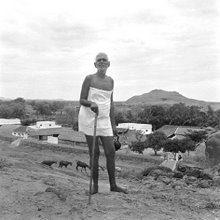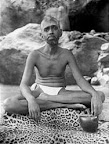SKIRTING Tiruchuzhi on the North Eastern and South Eastern sides is the Kaundinya river famed as the Redeemer of Sins. During a famine, the rishi [?] Kaundinya performed tapas [?] of Siva and this river was born. The king of Malva, Somasila, was a leper. He heard of this river as a Redeemer of Sins and bathed there. True to its name, the river cured him of leprosy. Such is the legend. The Tiruchuzhi tank had a peculiar feature. The water level of the tank was higher than the ground level of the town; yet the water never overflowed. Opposite the temple, there was a water bed known as Soola tirtham. The legend goes that during the deluge Lord Siva lifted that piece of land with his trident to save it from getting submerged. The water bed arose out of that — all the water sank into that space. Because of this water-bed the place got its name Tiru (sacred) chuzhi (swirl). The Soola-tirtham is to the east of the mantapa in the temple tank. During the month of Magha the water level of the tank would rise step by step and on the tenth day the tank would be full. Siva in the mantapa was thus given his abhisheka. Thereafter, the water level would go down during the next ten days. This was an unfailing phenomenon irrespective of the intensity of the rainfall. The water level here had nothing to do with the level of water in the town's wells. A bath in the waters of Soola tirtham would cure several skin ailments.
Sundaram Iyer bought a piece of land on the North Eastern end of the town and donated it to the public, to serve as a cremation ground.
In 1892 Sundaram Iyer fell ill. Subbu Iyer, along with his nephews visited him. But within four days he passed away. By then he was forty seven. Sundaram Iyer was cremated at the very ground donated by him.
Sundaram Iyer was popular and well-respected — even by way-laying robbers. He left behind four children - Nagaswami the eldest was fourteen, Venkataraman was twelve, Nagasundaram six and Alamelu was an infant. After the ceremonies Subbu Iyer returned to Madurai along with Nagaswami and Venkataraman whereas Alagamma stayed back with her two younger children. Their responsibility was taken over by Nelliappa Iyer, younger brother of Subbu Iyer.
After this calamity, Nagaswami began bestowing greater attention on his studies; but there was no change in Venkataraman at all. In addition to his old sports he learnt to swim either in the river Vaigai or in the Pillayar Tank. Also he learnt to throw and catch a small vessel full of water as if it were a ball without spilling even a drop of water. To indulge in their midnight games at the Vaigai the boys used to cover the bed with pillows which in turn were covered up by mattresses to give the impression that someone was asleep. They would jump over the wall and melt in the darkness outside. There was a garden close by and near its compound wall each member of the team used to leave a small stone to indicate that he was on his way to the Vaigai. The boys played till about two or three in the early hours and returned home. Apart from this, swimming in the swirling waters of the Vaigai during floods was another favourite sport of the boys.
Subbu Iyer moved over to a house in Chokkappa Naicken street.1
For his ninth standard, Venkataraman joined the American Mission High School. The college run by the same Mission was in its neighbourhood. Life was as usual, listless and aimless. He would visit Tiruchuzhi during vacations.
1This house has now been taken over by Sri Ramanasramam and is named "Ramana Mandiram". Daily pooja is performed here.
It was November 1895, Venkataraman was a student of ninth standard. He was on his way to the school at about ten in the morning, when he ran into Ramaswami Iyer, son of Lakshmana Iyer's brother — a resident of Tiruchuzhi. He was their relative, elderly too. Venkataraman, with natural affection, asked him, "Where are you coming from?" The reply was "From Arunachala." The word "Arunachala" was familiar to Venkataraman from his younger days, but he did not know where it was, what it looked like or what it meant. Yet that day that word meant to him something great, an inaccessible, authoritative, absolutely blissful entity. Could one visit such a place? His heart was full of joy. Arunachala meant some sacred land, every particle of which gave moksha [?]. It was omnipotent and peaceful. Could one behold it?
"What? Arunachala? Where is it?" asked the lad. The relative was astonished, "Don't you know even this?" and continued, "Haven't you heard of Tiruvannamalai? That is Arunachala." It was as if a balloon was pricked, the boy's heart sank.
Venkataraman had heard the name any number of times. Yet he was never moved. Why did it happen then?
No spiritual stirring had ever showed itself in Venkataraman's life till then. There were occasions when he had trifled with pooja articles too. He was so irreverent. He worshipped Siva routinely, visited temples on holy days as a formality but not because of any inner urge.
Once, on a night of festivities the boys went to Tirupparankundram. They were hungry but food was yet to be served. They hung around the kitchen. Just then the temple official went out on an errand. The boys opened the lock of the door, went in and took as much food as they wanted and went away to the river bank, had their fill, left behind the rest, washed themselves and went back to partake of the food being served! That was the boy's prasadam. Normally, nobody touches the food before it is offered to the deity because it is considered improper to do so. Long after this event Bhagavan said, "The food was indeed offered." How true it is! It was offered to the one for whom it was intended!
The Bible was taught at the school. Venkataraman was not interested even in the secular education imparted there — what to speak of the Bible?
Yet how did the emotional upsurge arise? What was the relation between Arunachala and Venkataraman?





No comments:
Post a Comment